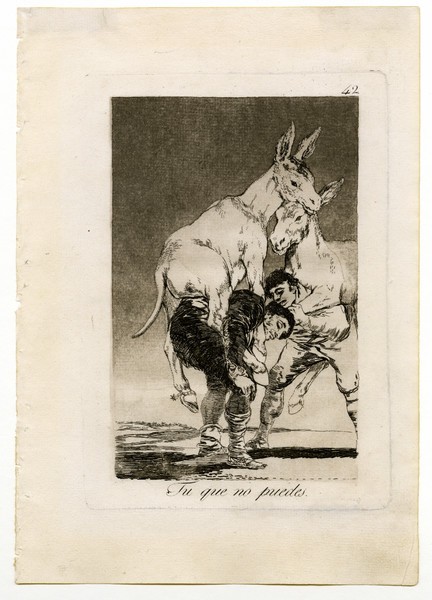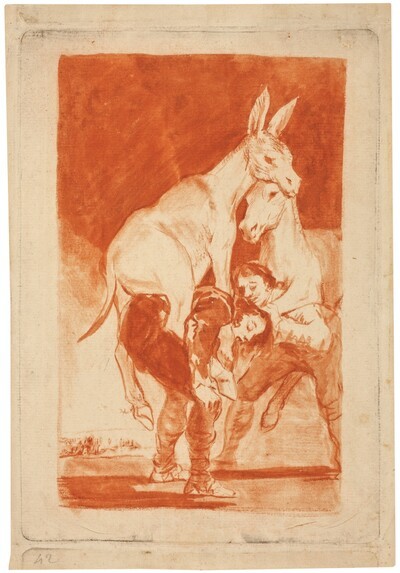- Cronología
- Ca. 1797 - 1799
- Dimensiones
- 218 x 152 mm
- Técnica y soporte
- Etching and burnished aquatint
- Reconocimiento de la autoría de Goya
- Undisputed work
- Ficha: realización/revisión
- 15 Dec 2010 / 29 May 2024
- Inventario
- 225
Tu que no puedes. (at the bottom)
42. (in the upper right-hand corner)
See Francisco de Goya y Lucientes, Painter.
Only one known proof before the handwriting is preserved in the Bibliothèque Nationale de France in Paris with the manuscript title, Como suben los borricos.
A preparatory drawing of this engraving is in the Prado Museum.
In the middle of the field, two peasants carry two donkeys on their shoulders, looking happy, while the farmers' faces reflect the dejection and weariness of such a heavy burden.
The aquatint forms a gradient in the sky that goes from the darkest at the top to the lightest at the bottom. Goya has also used the burnisher to create the effect of light on a low horizon.
This image is explained with great clarity in the manuscript in the National Library, which reads: "The poor and useful classes of society are those who carry the donkeys to bed, or bear the full weight of the contributions of the state". This interpretation ties in with the Report of the Economic Society of Madrid to the Royal and Supreme Council of Castile on the agrarian law that Gaspar Melchor de Jovellanos (Gijón, 1744-Puerto de Vega, Navia, 1811) published in 1795 in which he comments on the circumstances in which Spanish peasants found themselves: "Has it not been enough to aggravate their condition by imposing on them the taxes and services that the clergy, the nobility and other less respectable classes were dispensed with? (...) The heaviest and most costly pensions are daily being levied on the farmer as a result of the exemptions granted to other crafts and occupations. The quintas, the bagages, the lodgings, the collection of taxes and stamped paper, and all the council charges burden the unhappy farmer, while the individuals of other classes and professions are exempted from them with a generous hand. Cattle-breeding, carting, and the breeding of mares and colts have obtained them, as if these daughters or servants of agriculture were more worthy of favour than their mother and mistress. The employees of the royal hacienda, the capos de ronda, the guards, the tobacco, card and gunpowder tobacconists, the salt industry employees, and an incredibly large number of other jobs are granted an exemption not granted to the farm labourer".
In this print, the artist captures a vision of the world in which everything seems to work the other way round; it is no longer the men who ride on the backs of the donkeys, but the donkeys who carry them on their backs. Anna Pou points out that this vision has its origins in Aesop's fable of The Donkey and the Miller, which was widely disseminated in Europe throughout the 16th century.
It is also likely that the Aragonese painter had seen pre-revolutionary French prints in which the image of an animal on a person's shoulders was used to censure the enormous weight that people were forced to carry. These images were also valid for our country where, as we have seen, there was a significant increase in taxes to finance the wars and to pay for the privileges of the upper classes and the clergy.
Another hypothetical visual source from which Goya could have drawn inspiration is the coloured engraving by André Basset entitled A faut esperere q'eu se jeu la finira bentot (private collection).
The plate is preserved in the National Chalcography (no. 213).
-
De grafiek van GoyaRijksmuseum RijksprentenkabinetAmsterdam1970from November 13th 1970 to January 17th 1971cat. 35
-
Goya. Das Zeitalter der Revolucionen. Kunst um 1800 (1980 – 1981)Hamburger KunsthalleHamburg1980cat. 56
-
Goya y el espíritu de la IlustraciónMuseo Nacional del PradoMadrid1988from October 6th to December 18th 1988. Exhibited also at Museum of Fine Arts, Boston, January 18th to March 26th 1989; The Metropolitan Museum of Art, Nueva York, May 9th to July 16th 1989, Madrid curator Manuela B. Mena Marqués, scientific directors Alfonso E. Pérez Sánchez and Eleanor A. Sayrecat. 49
-
Goya. La década de Los CaprichosMadrid1992organized by Real Academia de Bellas Artes de San Fernando sponsored by Fundación Central Hispano, Madrid, consultant editor Nigel Glendinnig. From October 26th 1992 to January 10th 1993cat. 140
-
Francisco de GoyaMuseo d'Arte ModernaLugano1996exhibition celebrated from September 22nd to November 17th.cat. 42, p.69
-
Ydioma universal: Goya en la Biblioteca NacionalBiblioteca NacionalMadrid1996from September 19th to December 15th 1996cat. 137
-
Francisco Goya. Sein leben im spiegel der graphik. Fuendetodos 1746-1828 Bordeaux. 1746-1996Galerie KornfeldBern1996from November 21st 1996 to January 1997cat. 48
-
Das Capriccio als KunstprinzipWallraf-Richartz-Museum,1996from December 8th 1996 to February 16th 1997, exhibited also in Zurich, Kunsthaus, from March 14th marzo 1997 to June 1st 1997 and in Vienna, Kunsthistorisches Museum mi Palais Harrach, from June 29th 1997 to September 21st 1997.cat. G. 36
-
Goya artista de su tiempo y Goya artista únicoThe National Museum of Western ArtTokyo1999from December 1st to July 3th 1999cat. 120
-
Goya e la tradizione italianaFondazione Magnani RoccaMamiano di Traversetolo (Parma)2006consultant editors Fred Licht and Simona Tosini Pizzetti. From September 9th to December 3th 2006cat. 42, p.156
-
Goya. Opera graficaPinacoteca del Castello di San GiorgioLegnano2006exhibition celebrated from December 16th 2006 to April 1st 2007p.34
-
Goya e ItaliaMuseo de ZaragozaZaragoza2008organized by the Fundación Goya en Aragóna, consultant editor Joan Sureda Pons. From June 1st to September 15th 2008cat. 42
-
Goya et la modernitéPinacothèque de ParisParís2013from October 11st 2013 to March 16th 2014cat. 155
-
Goya: Order and disorderMuseum of Fine ArtsBoston2014cat. 233
-
Goya engravings and lithographs, vol. I y II.OxfordBruno Cassirer1964p.114, cat. 77
-
Vie et ouvre de Francisco de GoyaParísOffice du livre1970p.181, cat. 534
-
Goya, la década de los caprichos: dibujos y aguafuertesMadridReal Academia de Bellas Artes de San Fernando1992pp.233-236, cat. 139-141
-
Catálogo de las estampas de Goya en la Biblioteca NacionalMadridMinisterio de Educación y Cultura, Biblioteca Nacional1996p.96, cat. 131
-
El libro de los caprichos: dos siglos de interpretaciones (1799-1999). Catálogo de los dibujos, pruebas de estado, láminas de cobre y estampas de la primera ediciónMadridMuseo Nacional del Prado1999pp.234-237
-
Francisco Goya. Los CaprichosBarcelonaEdiciones de la Central2011pp.48-50
-
ParísPinacoteca de París2013p. 220
-
Goya: Order & DisorderBostonMuseum of Fine Arts Boston Publications2014pp. 336-337
-
Goya. In the Norton Simon MuseumPasadenaNorton Simon Museum2016pp. 42-75

